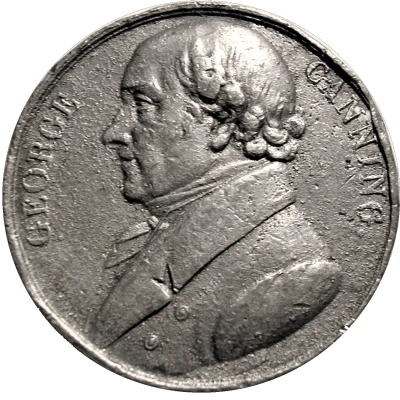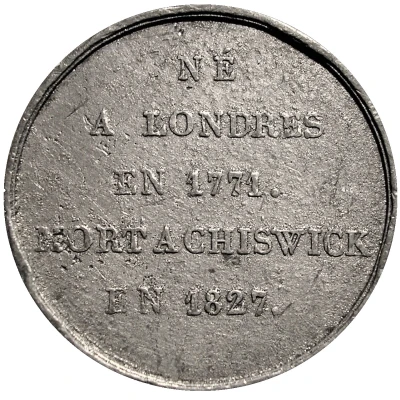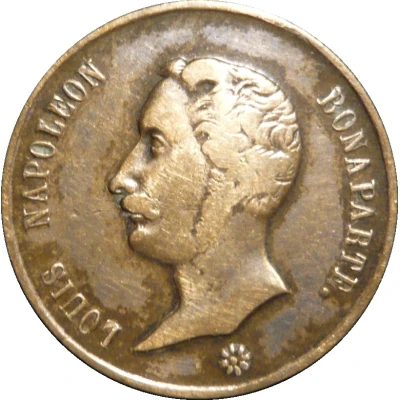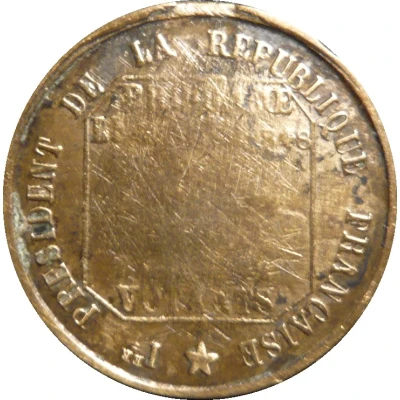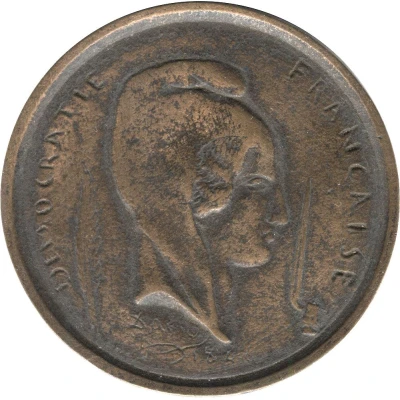
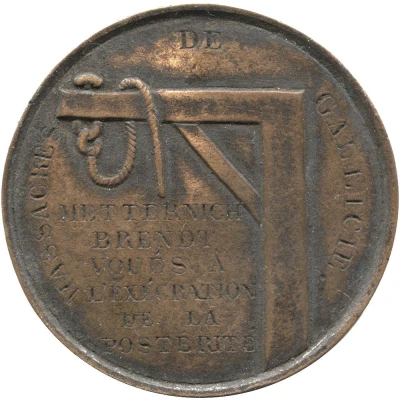

Souvenir des Massacres de Galicie Pologne
1846 year| Copper | 19.05 g | 40.5 mm |
| Location | France |
|---|---|
| King | Louis Philippe I (Louis-Philippe Ier) (1830-1848) |
| Type | Medals › Commemorative medals |
| Year | 1846 |
| Currency | France - Political Tokens |
| Composition | Copper |
| Weight | 19.05 g |
| Diameter | 40.5 mm |
| Thickness | 2.2 mm |
| Shape | Round |
| Technique | Milled |
| Orientation | Medal alignment ↑↑ |
| Updated | 2024-11-12 |
| Numista | N#426169 |
|---|---|
| Rarity index | 97% |
Reverse
Rope knotted on a gallows, circular legend around and 6 lines below the gallows.
Script: Latin
Lettering:
MASSACRES DE GALLICIE
METTERNICH
BRENDT
VOUÉS À
L’ÉXÉCRATION
DE LA
POSTÉRITÉ.
Edge
Plain
Comment
The Galician Massacre
"The Galician Massacre" also named "Peasant Uprising of 1846" or "Szela Uprising" (German: Galizisches Gemetzel; Polish: Rzeź galicyjska or Rabacja galicyjska) was a Polish peasant uprising that lasted two months and helped end another uprising - the Kraków szlachta uprising, then a free republic - with the massacre of the Austrian Galician szlachta during February and March 1846. This uprising was aimed at abolishing serfdom and was directed against seigneurial property and rights (e.g. corporal punishment, seigneurial prisons, etc.).
It caused a great deal of death and destruction. Galician peasants, mainly Poles, killed around a thousand members of the nobility and destroyed around 500 castles and manors. The Austrian government used the insurrection to decimate the nationalist Polish nobility, who were planning an insurrection against Austria. It was the largest peasant revolt on Polish soil in the 19th century.
The massacre, led by Jakub Szela, began on February 18, 1846. In three districts: Sanok, Jasło and Tarnów, Szela's groups surrounded and attacked manor houses and inhabited places.
In the Free City of Kraków (Republic of Kraków), a few noble democrats tried to persuade the peasants to rise up against Austria. The insurrection began in February 1846 and was supported by the most "advanced" peasants in the Kraków region. However, most peasants in Austrian Poland (Galicia) were undernourished due to poor harvests and, above all, hated their lords. The peasants, incited by Austrian power, attacked the nobility, looting their property and killing the landlords who were among the leaders of the independence movement. The peasants accused them of being repressed by the occupying authorities. The occupying authorities paid them for every presentation of a member of the Tarnów City Council or a member of the nobility. In addition, the Austrians offered money for every severed head of a Polish noble.
A similar szlachta insurrection was also planned in Poznań, but the police soon captured the ringleaders. In contrast, the Tarnów district official panicked and asked the peasants for help.
Some Austrian officials called on the province's peasantry to be loyal to the emperor and resist against the insurgent Polish szlachta. The lesser nobility learned from this that the Polish peasants were not sympathetic to the cause of insurrectionary Polish nationalism, and preferred to rely on the Habsburg dynasty for the time being. Many Galician nobles also came to the same conclusion.
The Republic of Krakow was abolished and incorporated into Galicia.
Serfdom existed in Galicia until April 22, 1848. Its abolition was the immediate consequence of the peasants' insurrection against the local Polish nobility. The lot of the Galician peasantry was fundamentally improved.
